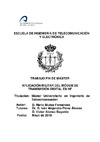Please use this identifier to cite or link to this item:
https://accedacris.ulpgc.es/jspui/handle/10553/77563
| DC Field | Value | Language |
|---|---|---|
| dc.contributor.advisor | Pérez Álvarez, Iván Alejandro | es |
| dc.contributor.advisor | Alonso Eugenio, Victor | es |
| dc.contributor.author | Muñoz Fernández, Mario | es |
| dc.date.accessioned | 2021-02-08T08:44:19Z | - |
| dc.date.available | 2021-02-08T08:44:19Z | - |
| dc.date.issued | 2019 | - |
| dc.identifier.uri | https://accedacris.ulpgc.es/handle/10553/77563 | - |
| dc.description.abstract | Actualmente las comunicaciones militares no avanzan a la misma velocidad que las comunicaciones civiles. La carencia de infraestructuras en las zonas de operaciones a lo largo del planeta dificulta el enlace permanente entre las unidades desplegadas. La radio HF supone una solución para solventar este tipo de inconvenientes, al conseguir enlaces transhorizonte con equipos fáciles de transportar y poner en funcionamiento. Sin embargo, el avance de las tecnologías obliga a mejorar las capacidades de los equipos militares, no siendo suficiente un enlace sólo de voz. Por todo ello, en este trabajo se analiza el Módem HFDVL, capaz de establecer enlaces HF digitales con un ancho de banda significativo que permite el uso de mensajería instantánea y el envío de archivos en un medio con condiciones muy adversas, gracias al algoritmo implementado por la Universidad de Las Palmas de Gran Canaria. | en_US |
| dc.description.abstract | Currently, military communications do not advance at the same speed as civil communications. The lack of infrastructures in the areas of operations throughout the planet hinders the permanent link between the deployed units. The HF radio supposes a solution to solve this type of inconveniences, when obtaining transhorizonte connections with equipment easy to transport and put in operation. However, the advance of the technologies forces to improve the capacities of the military equipment, not being sufficient only a voice link. For all these reasons, this paper analyzes the HFDVL Modem, capable of establishing digital HF links with a significant bandwidth that allows the use of instant messaging and the sending of files in a medium with very adverse conditions, thanks to the algorithm implemented by the Universidad de Las Palmas de Gran Canaria. | en_US |
| dc.language | spa | en_US |
| dc.subject | 3325 Tecnología de las telecomunicaciones | en_US |
| dc.title | Aplicación militar del módem de transmisión digital en HF | es |
| dc.type | info:eu-repo/semantics/masterThesis | en_US |
| dc.type | MasterThesis | en_US |
| dc.contributor.departamento | Departamento de Señales Y Comunicaciones | es |
| dc.contributor.facultad | Escuela de Ingeniería de Telecomunicación y Electrónica | en_US |
| dc.investigacion | Ingeniería y Arquitectura | en_US |
| dc.type2 | Trabajo final de máster | en_US |
| dc.utils.revision | Sí | en_US |
| dc.identifier.matricula | TFT-51750 | es |
| dc.identifier.ulpgc | Sí | en_US |
| dc.contributor.buulpgc | BU-TEL | es |
| dc.contributor.titulacion | Máster Universitario en Ingeniería de Telecomunicación | es |
| item.fulltext | Con texto completo | - |
| item.grantfulltext | restricted | - |
| crisitem.advisor.dept | GIR IDeTIC: División de Ingeniería de Comunicaciones | - |
| crisitem.advisor.dept | IU para el Desarrollo Tecnológico y la Innovación | - |
| crisitem.advisor.dept | GIR IDeTIC: División de Ingeniería de Comunicaciones | - |
| crisitem.advisor.dept | IU para el Desarrollo Tecnológico y la Innovación | - |
| Appears in Collections: | Trabajo final de máster Restringido ULPGC | |
Page view(s)
198
checked on Aug 12, 2023
Download(s)
60
checked on Aug 12, 2023
Google ScholarTM
Check
Share
Export metadata
Items in accedaCRIS are protected by copyright, with all rights reserved, unless otherwise indicated.
